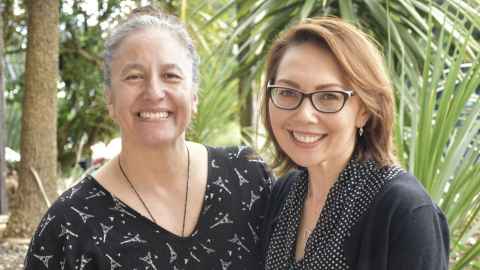Same barriers exist for Māori and Pacific heart health care
10 June 2024
New study shows same old barriers for Māori and Pacific.

A major study in the heart health care space shows Māori and Pacific peoples are still experiencing inequities.
The research project led by Senior Research Fellow Dr Corina Grey (Alafua, Tafitoala, Vailima, Safune and Gataivai - Sāmoa) and Associate Professor Matire Harwood KSM (Ngāpuhi, Ngāti Rangi, Te Mahurehure and Ngāti Hine) was launched four years ago.
Senior research fellow and Co-Director of Pūtahi Manawa Dr Karen Brewer (Whakatōhea, Ngaiterangi) says the research programme Manawataki Fatu Fatu for ACCESS - Māori and Pacific hearts in unison for Achieving Cardiovascular Care in Equity StudieS - aims to identify gaps along the healthcare continuum, and address and improve health outcomes for Māori and Pacific people in Aotearoa New Zealand.
More than 20,000 Māori and about 7000 Pasifika are living with heart related conditions. Using kaupapa Māori and Pacific research methods, the study looked into how the risk of these conditions are assessed and managed, and what can be done to reduce delays and improve access to hospital care for these groups.
Over the past three years, Dr Brewer led a major piece of work, and the study - qualitative interviews with Māori and Pacific people about their experiences of heart health care, has just been published.
It showed many barriers are longstanding and continue to affect Māori and Pacific peoples with heart related conditions. Despite a strong desire to take charge of their health, the same challenges stifled better outcomes.
“It’s the same old, same old. It’s almost new, that it’s not new,” says Dr Brewer.
She said the need for education, especially among health professionals, with an emphasis on cultural safety aspects was demonstrated in the research findings.
We value relationships, reciprocity and communication, there is a lot that doesn’t work for Māori and Pacific because the health system is not a Māori and Pacific system.

Higher risk at a younger age
Cardiovascular or heart checks are regularly carried out through the testing of bloods, cholesterol, and blood pressure. For people who are not Māori, Pacific or South Asian, and have no known risk factors, this means testing men from age 45 and women 55. However for Māori and Pacific, the ages are lower; testing men from 30 and women from 40.
Dr Brewer says this is reflective of having a higher risk at a younger age.
The study confirmed that the social determinants of health played an important role in increased risk for Maori and Pacific people: housing, education, access to good nutrition and poverty etc.
However, differences in access to and quality of health treatment were also experienced by the participants and so having clarity around this was important to address the identified gaps.
“We value relationships, reciprocity and communication, there is a lot that doesn’t work for Māori and Pacific because the health system is not a Māori and Pacific system.”
These communities were not seeing themselves in the health care professionals they engaged with, and Dr Brewer says continuity in care, which no longer seemed to be valued by the health system, made a marked difference to the treatment received.
“There is a difference in regularly seeing your GP and if possible, the same GP.”
People who had regular care were able to get an earlier diagnosis, and people receiving regular care were more likely to engage with the treatment, as well as take charge of their care. These things are more likely to occur when there was a positive relationship between patient and provider.
The need for a representative workforce
There was a call to action to increase the Māori and Pacific health workforce, Dr Brewer says emphasising the vital role of the MAPAS programme at the University and Te Kauae Parāoa at Otago University.
Nurturing children and introducing health career pathways from as early as primary school could help the next generation of Māori and Pacific communities see themselves as future health professionals and researchers.
Researcher and former nurse, Dr Tua Taueetia-Su’a said the study showed the importance of developing the workforce. From building the number of Māori and Pacific health professionals as well as training all providers in cultural safety.
Study participants said it could be as simple as having family members present when receiving care and for health professionals to engage with all family, and not just the patient.